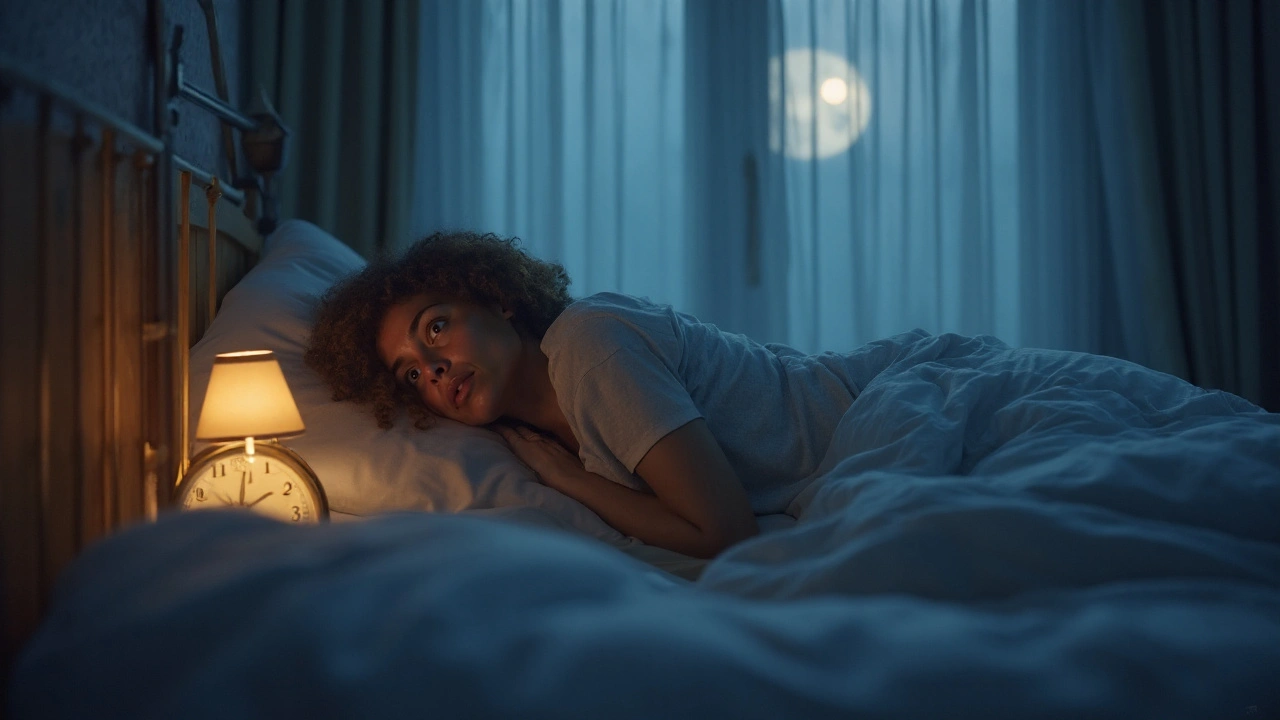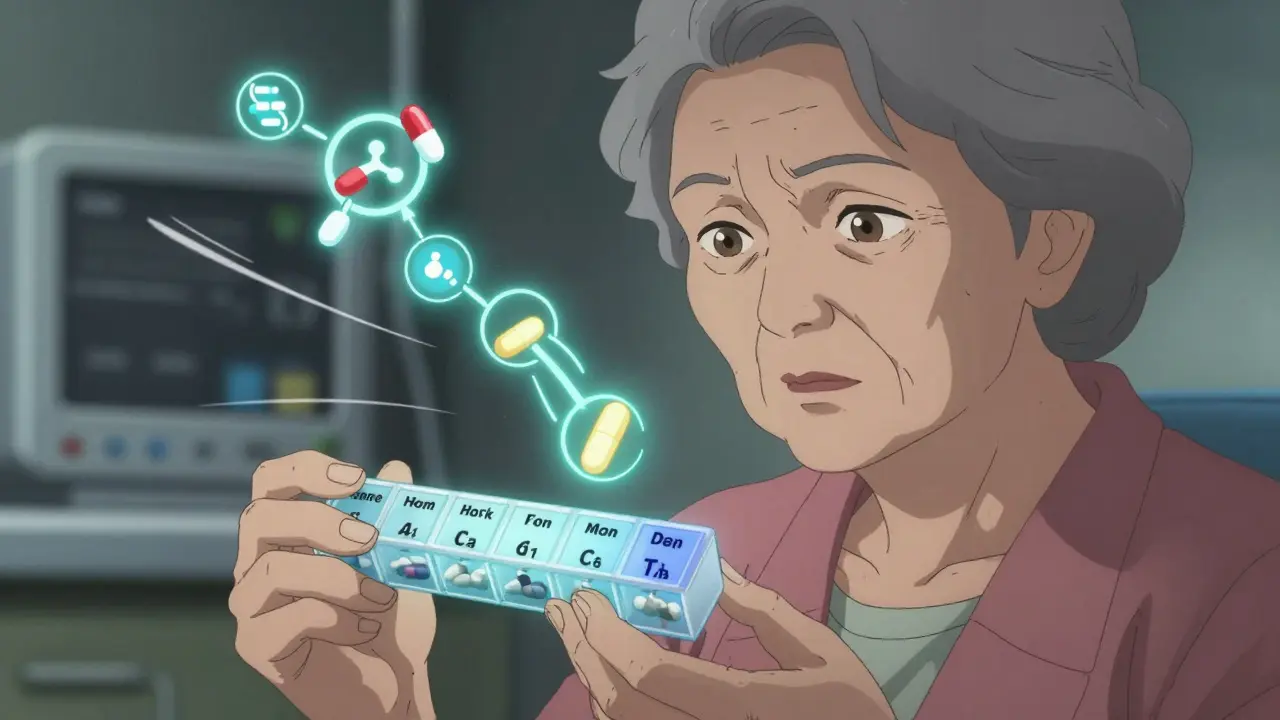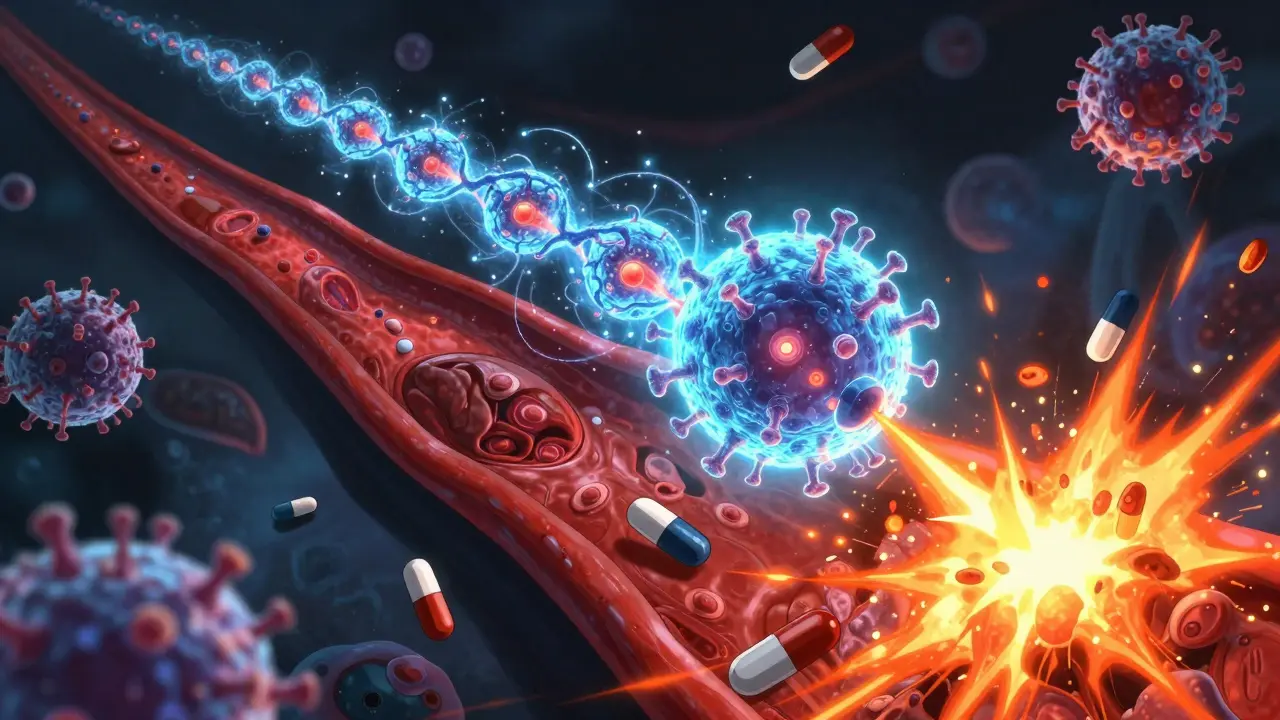How Paget's Disease Disrupts Sleep and Triggers Fatigue

Paget's disease is a chronic bone disorder that disrupts normal bone remodeling, leading to enlarged, misshapen bones and a range of systemic symptoms. It primarily affects older adults, with an estimated prevalence of 1‑3% in people over 55 years old in the UK. Paget's disease isn’t just about creaky joints - many patients report night‑time awakenings, restless tossing, and a lingering sense of exhaustion that can feel unrelated to the bone changes themselves.
Why Sleep Takes a Hit
The link between bone remodeling is a lifelong process where osteoclasts break down old bone and osteoblasts build new bone. In Paget’s disease, osteoclast activity goes into overdrive, creating chaotic bone turnover. This biochemical chaos raises local temperature and triggers inflammatory mediators such as prostaglandins, which are notorious for causing pain and fever.
Prostaglandin spikes also affect the hypothalamus, the brain’s temperature‑regulation centre, making it harder to achieve the cool-down phase needed for deep sleep. Patients often describe a “burning” feeling in the affected limb that worsens at night, prompting frequent bathroom trips or repositioning.
Another key player is chronic pain persistent discomfort that lasts longer than three months. Pain signals fire up the sympathetic nervous system, raising cortisol levels and disrupting the natural rise‑and‑fall of melatonin, the hormone that tells us when to sleep.
Understanding Fatigue Beyond Tiredness
Fatigue in Paget’s disease isn’t just a side‑effect of a bad night’s sleep; it’s a multidimensional syndrome. The body’s constant effort to repair abnormal bone consumes extra energy, diverting glucose and oxygen away from muscles and the brain.
Coupled with osteoclast activity the accelerated breakdown of bone tissue, the immune system stays on high alert, releasing cytokines like IL‑6 and TNF‑α. These cytokines are known to cause “sickness behaviour” - a feeling of lethargy, reduced motivation, and mental fog.
When sleep quality deteriorates, the body can’t clear these inflammatory by‑products efficiently, creating a vicious cycle: poor sleep fuels inflammation, which in turn deepens fatigue.
Interplay With Mood and Cognitive Function
It’s common for patients to develop depression a mood disorder marked by persistent sadness and loss of interest alongside sleep disturbance. The overlap isn’t coincidental; shared neurochemical pathways (serotonin, norepinephrine) link pain, sleep, and mood.
Research from the British Society for Bone Health (2023) showed that 38% of people with active Paget’s disease scored in the moderate‑to‑severe range on the PHQ‑9 depression questionnaire, compared with 12% in age‑matched controls. Cognitive complaints - forgetfulness, slower processing speed - often stem from fragmented sleep rather than direct bone pathology.
Diagnostic Tools: Pinpointing the Sleep‑Fatigue Axis
Standard blood tests (elevated alkaline phosphatase) and X‑rays confirm the skeletal disease, but evaluating sleep requires dedicated tools.
- Polysomnography overnight sleep study measuring brain waves, oxygen levels, heart rate, and muscle activity can reveal reduced REM sleep and frequent micro‑arousals linked to bone‑related pain.
- Actigraphy watches provide a less invasive way to track sleep‑wake patterns over weeks, helping clinicians see if fatigue correlates with night‑time movement.
- Patient‑reported outcome measures such as the Pittsburgh Sleep Quality Index (PSQI) and the Fatigue Severity Scale (FSS) give quantifiable scores to monitor progress.
Combining these objective measures with biochemical markers gives a full picture of how the disease is affecting nocturnal rest.
Management Strategies That Target Both Bone Health and Sleep
The cornerstone of Paget’s disease treatment is reducing abnormal bone turnover. Several pharmacologic options exist, each with different implications for sleep and fatigue.
| Treatment | Mechanism | Effect on Sleep | Common Side Effects |
|---|---|---|---|
| Bisphosphonate therapy | Inhibits osteoclast‑mediated bone resorption | Improves sleep within weeks by lowering pain | Flu‑like symptoms, gastrointestinal upset |
| Calcitonin | Directly suppresses osteoclast activity | Modest sleep benefit; may cause nasal irritation if nasal spray | Nausea, nasal congestion |
| Denosumab | Monoclonal antibody blocking RANKL, halting bone breakdown | Potentially rapid pain relief → better sleep | Hypocalcemia, injection site reactions |
| NSAIDs | Reduce inflammation and pain | Short‑term sleep aid via pain control only | Gastrointestinal bleeding, kidney strain |
Among these, bisphosphonate therapy is the most widely used because it offers the quickest reduction in alkaline phosphatase levels, which correlates with pain lessening and, consequently, improved sleep quality.
Adjunctive measures can amplify the effect:
- Schedule the dose in the morning to avoid nighttime flu‑like reactions that could disturb sleep.
- Combine with a low‑dose calcium essential mineral for bone health and vitamin D facilitates calcium absorption supplementation to prevent hypocalcemia, a known cause of nocturnal muscle cramps.
- Introduce a gentle bedtime routine: warm bath, dim lighting, and a short meditation to lower cortisol levels.

Lifestyle Tweaks That Reduce Night‑Time Discomfort
Even with optimal medication, daily habits matter. Here are practical steps that target the sleep‑fatigue loop:
- Temperature control: Keep the bedroom at 18‑20°C; cooler environments ease prostaglandin‑induced heat sensations.
- Positioning aids: Use a pillow under the affected limb to reduce pressure points and limit bone‑related night pain.
- Gentle stretching: Light range‑of‑motion exercises in the evening improve circulation without triggering the bone‑pain flare.
- Limit stimulants: Cut caffeine after 2p.m.; nicotine and alcohol can exacerbate sleep fragmentation.
- Mind‑body techniques: Progressive muscle relaxation or guided imagery has been shown in a 2022 European Journal of Pain study to lower pain‑related awakenings by 30%.
Related Conditions Worth Watching
Paget’s disease can coexist with other disorders that also muddy the sleep picture. Recognising these helps avoid misattribution of symptoms.
- Osteoarthritis degenerative joint disease causing cartilage loss - often shares joint pain but lacks the high alkaline phosphatase.
- Fibromyalgia central sensitisation syndrome marked by widespread musculoskeletal pain - may amplify fatigue and sleep disturbance independently of bone turnover.
- Obstructive sleep apnea airway collapse during sleep causing intermittent hypoxia - can be mistaken for fatigue caused by Paget’s disease alone.
Screening for these comorbidities using appropriate questionnaires (e.g., STOP‑BANG for sleep apnea) ensures a comprehensive treatment plan.
Future Directions and Ongoing Research
Scientists are probing the genetic under‑pinnings of Paget’s disease, focusing on the SQSTM1 gene. Early‑phase trials are testing newer RANKL inhibitors that may offer faster symptom relief with fewer gastrointestinal side effects, potentially translating into better sleep outcomes.
Meanwhile, digital health platforms are integrating actigraphy data with electronic health records, allowing clinicians to track sleep trends in real time and adjust therapy before fatigue becomes debilitating.
Take‑Home Checklist
- Confirm diagnosis with elevated alkaline phosphatase and imaging.
- Assess sleep quality using PSQI and consider polysomnography if needed.
- Start bisphosphonate therapy, monitor alkaline phosphatase decline.
- Address pain promptly - NSAIDs or calcitonin as bridge therapy.
- Implement bedroom temperature, positioning, and relaxation routines.
- Screen for depression, anxiety, and other sleep‑related disorders.
- Re‑evaluate fatigue scores after 3months of treatment.
Frequently Asked Questions
Can Paget's disease cause insomnia?
Yes. The excess bone turnover releases inflammatory mediators that raise body temperature and trigger night‑time pain, both of which can interrupt the ability to fall asleep and stay asleep.
How quickly does bisphosphonate therapy improve sleep?
Most patients notice a reduction in pain within 2‑4 weeks, which usually translates into better sleep quality by the end of the first month.
Is daytime fatigue always linked to poor sleep?
Not always. Fatigue can also stem from the metabolic cost of constant bone remodeling and from cytokine‑driven inflammation, even if the person gets sufficient hours of sleep.
Should I get a sleep study if I have Paget's disease?
A polysomnography is recommended when standard questionnaires reveal severe sleep disruption, or when other sleep disorders (like apnea) are suspected.
Can lifestyle changes alone fix the sleep problems?
Lifestyle tweaks (room temperature, bedtime routine, gentle stretching) greatly reduce night‑time discomfort but usually need to be combined with medical therapy for lasting relief.
Are there any new drugs on the horizon?
Early trials of next‑generation RANKL inhibitors and gene‑targeted therapies are promising, aiming for faster symptom control with fewer side effects, which could further improve sleep outcomes.






Comments
Sean Lee
September 24, 2025 AT 18:25From a mechanistic standpoint, the hyperactive osteoclastic cascade in Paget's disease precipitates a metabolic milieu that undermines homeostatic sleep regulation. The proinflammatory prostaglandin surge exerts thermogenic effects, thereby destabilizing the circadian set‑point. Moreover, nociceptive input engages the sympathetic axis, augmenting cortisol output and attenuating melatonin synthesis. This neuroendocrine dysregulation manifests as fragmented REM cycles and heightened arousal thresholds. Consequently, patients experience a pernicious feedback loop wherein bone pathology begets sleep disturbance, which in turn exacerbates inflammatory signaling.
Michael Christian
September 24, 2025 AT 19:15Man, I get why people feel wiped out. If your bones are constantly “working overtime,” it’s no surprise you’re running on empty. A good night’s sleep can feel like a distant memory when the pain’s kicking you around at 2 a.m. Throw in some meds and a chill bedtime vibe, and you’ll start seeing a lift.
Steven Elliott
September 24, 2025 AT 20:05Oh great, another excuse to stay up binge‑watching.
Lawrence D. Law
September 24, 2025 AT 20:55It is imperative to underscore that the epidemiological data unequivocally indicate a correlation between elevated alkaline phosphatase levels and nocturnal discomfort; accordingly, therapeutic regimens must be meticulously calibrated to mitigate these adverse outcomes.
Mary K
September 24, 2025 AT 21:45Hey folks, let’s break this down in plain English while still keeping it spicy! First off, think of your bones like a factory that’s gone rogue – the workers (osteoclasts) are hammering away nonstop, producing heat and chaos. That heat isn’t just a random sensation; it triggers those nasty prostaglandins that act like tiny firecrackers in your nervous system, screaming “I’m in pain!” every night.
Now, imagine trying to fall asleep while a fire alarm is blaring – that’s your hypothalamus trying to cool down a furnace that just won’t quit. The result? Tossing, turning, and that dreaded middle‑of‑the‑night bathroom dash because your limb feels like it’s on fire.
On top of the physical discomfort, the body’s stress response kicks in. The sympathetic nervous system revs up, cortisol spikes, and melatonin (the sleep hormone) gets the short end of the stick. This hormonal tug‑of‑war makes deep sleep feel like a distant memory.
But that’s not all. Your body’s trying to repair those “over‑active” bones, which eats up a ton of energy – think of it as a car engine idling full‑blast while you’re trying to cruise peacefully. That extra metabolic demand saps glucose and oxygen from muscles and your brain, leaving you feeling foggy and unmotivated.
Layer in the inflammatory cytokines – IL‑6, TNF‑α – and you’ve got a perfect storm of “sickness behaviour.” That’s the scientific term for that heavy, lethargic feeling that makes even simple tasks feel like climbing a mountain.
And let’s not forget the mental side‑effects. The chronic pain and sleep fragmentation tug at serotonin and norepinephrine pathways, which are the same highways that mood and cognition travel on. No wonder a sizable chunk of patients end up battling depression and brain‑fog.
So what can you do? Start with the big guns: bisphosphonate therapy. It’s the champion at lowering alkaline phosphatase, easing bone pain, and giving your sleep a fighting chance within weeks. Pair that with a solid bedtime routine – cool room, dim lights, perhaps a short meditation – to calm cortisol.
Don’t underestimate the power of simple lifestyle tweaks: keep the bedroom cool (18‑20 °C), prop up the affected limb with a pillow, stretch gently before bed, and cut caffeine after mid‑afternoon. Even a 30% reduction in night‑time awakenings has been documented with progressive muscle relaxation techniques.
Lastly, screen for comorbidities. Sleep apnea, osteoarthritis, and fibromyalgia can masquerade as Paget‑related fatigue, so a STOP‑BANG questionnaire or a quick talk with your doc can keep you from missing the bigger picture.
Bottom line: treat the bone disease, tame the inflammation, and craft a sleep‑friendly environment – and you’ll start reclaiming that precious energy you deserve.
Odin Zifer
September 24, 2025 AT 22:35What they don’t tell you is that the “sleep studies” are just a cover for big pharma to push more drugs. You’re better off tracking your own patterns with a cheap smartwatch and ignoring the corporate labs.
Marisa Leighton
September 24, 2025 AT 23:25Wow, this is exactly what I needed! Your checklist is spot‑on. I’ve been battling those nightly bone‑twinges for months, and the tip about a pillow under the limb is a game‑changer. Keep the good info coming!
Brennan Keeler
September 25, 2025 AT 00:15Honestly, the bisphosphonate protocol is the only logical approach. Anything else is a diversion. Get the dose early, monitor ALP, and you’ll see the pain diminsh - period.
Chelsea Hackbarth
September 25, 2025 AT 01:05Great read! 👍👍 Sleep quality makes such a difference. 🌙💤
Adam Shooter
September 25, 2025 AT 01:55While the article is thorough, the omission of the socioeconomic factors influencing access to bisphosphonates is a glaring oversight. A nuanced analysis would incorporate health disparity metrics.
Shanmughasundhar Sengeni
September 25, 2025 AT 02:45Interesting points, but the writer seems to have skimmed over the mechanistic pathways. A deeper dive into RANKL signaling would elevate the discussion.
ankush kumar
September 25, 2025 AT 03:35Hey friends, just wanted to add that I’ve been using a combination of low‑dose vitamin D3 and magnesium before bed – it’s helped calm the nocturnal cramps that sometimes wake me up. Also, I set a gentle alarm to do a quick 5‑minute walk around the house before going back to sleep; that little movement seems to reset my circulation and reduces the “burning” sensation in the affected limb. Lastly, I’ve found that keeping a gratitude journal for a few minutes each night before lights out not only helps with the mental fog but also seems to lower my cortisol levels – at least that’s what the studies suggest. So, feel free to experiment with these small lifestyle tweaks alongside your medical regimen. Consistency is key, and you’ll likely notice incremental improvements over weeks.
Cameron White
September 25, 2025 AT 04:25Honestly, all these medical interventions sound like a distraction from the real issue – it’s all a conspiracy to keep us dependent on pharma. Trust your body, not the pills.
Amélie Robillard
September 25, 2025 AT 05:15So basically, if you can’t sleep because your bones are acting like a furnace, just chill and maybe try a duvet that’s not too warm? 😂 Anyway, I’m all for the bedtime routine – a warm bath sounds nice.
Fae Wings
September 25, 2025 AT 06:05Reading this gave me a mix of hope and anxiety. I’ve struggled with the nighttime pain for years, and the idea that a simple temp adjustment could help is uplifting. Thank you for the empathy and practical tips.
Anupama Pasricha
September 25, 2025 AT 06:55I appreciate the comprehensive overview. It’s crucial to consider comorbidities like sleep apnea, as they can exacerbate fatigue independent of bone disease.
Bryce Charette
September 25, 2025 AT 07:45Good summary. I’d add that patients should double‑check dosing instructions to avoid the acute flu‑like reaction that can mess up sleep.
Christina Burkhardt
September 25, 2025 AT 08:35That’s a solid checklist! I’d also suggest a quick check‑in with a physiotherapist to tailor gentle evening stretches – it can make a big difference.
liam martin
September 25, 2025 AT 09:25Sleep, pain, bone remodeling – the eternal triangle of misery. Yet here we are, chasing the elusive dream of a full night’s rest.
Bridgett Hart
September 25, 2025 AT 10:15I’m glad the article highlighted the link between cytokines and daytime fatigue; it’s something many patients overlook when they blame “just aging.”